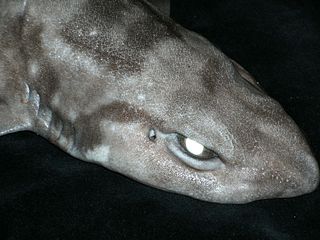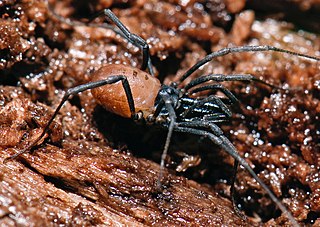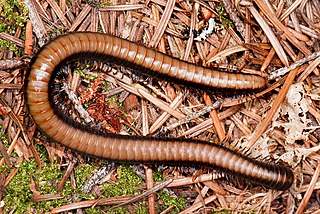
Pseudoscorpions, also known as false scorpions or book scorpions, are small, scorpion-like arachnids belonging to the order Pseudoscorpiones, also known as Pseudoscorpionida or Chelonethida.

Pinus strobus, commonly called the eastern white pine, northern white pine, white pine, Weymouth pine (British), and soft pine is a large pine native to eastern North America. It occurs from Newfoundland, Canada, west through the Great Lakes region to southeastern Manitoba and Minnesota, United States, and south along the Appalachian Mountains and upper Piedmont to northernmost Georgia and perhaps very rarely in some of the higher elevations in northeastern Alabama. It is considered rare in Indiana.

The American water shrew or northern water shrew is a shrew found in the nearctic faunal region located throughout the mountain ranges of the northern United States and in Canada and Alaska. The organism resides in semi-aquatic habitats, and is known for being the smallest mammalian diver.

The marsh shrew, also known as the Pacific water shrew, Bendire's water shrew, Bendire's shrew and Jesus shrew is the largest North American member of the genus Sorex. Primarily covered in dark-brown fur, it is found near aquatic habitats along the Pacific coast from southern British Columbia to northern California. With air trapped in its fur for buoyancy, marsh shrews can run for three to five seconds on top of the water. It measures about 16 cm (6.3 in) in length, including a 7-centimetre (2.8 in)-long tail, and weighs an average of 14.5–16 g (0.51–0.56 oz). The marsh shrew's diet consists mainly of invertebrates, which it hunts on land and in the water. They are rare; their populations are thought to be in decline, and they are considered endangered in parts of their range.

Tsuga heterophylla, the western hemlock or western hemlock-spruce, is a species of hemlock native to the west coast of North America, with its northwestern limit on the Kenai Peninsula, Alaska, and its southeastern limit in northern Sonoma County, California. The Latin species name means 'variable leaves'.

Sternotherus odoratus is a species of small turtle in the family Kinosternidae. The species is native to southeastern Canada and much of the Eastern United States. It is also known commonly as the common musk turtle, eastern musk turtle, or stinkpot turtle due to its ability to release a foul musky odor from scent glands on the edge of its shell, possibly to deter predation. This turtle is grouped in the same family as mud turtles.

The Dinagat bushy-tailed cloud rat, Dinagat crateromys or Dinagat cloud rat is a species of cloud rat in the family Muridae. It is one of the eight cloud rats found only in the Philippines, and is specifically endemic to Dinagat Island. It is known locally as hawili. A single specimen was discovered in 1975 by Dioscoro S. Rabor and his team during a scientific survey in Dinagat. The natural habitat is tropical lowland forests, which are facing environmental threats. Habitat loss is caused by progressive deforestation from heavy logging and chromite mining in the area. Almost 40 years after the original discovery, five live specimens were discovered by Milada Řeháková, Václav Řehák and William L.R. Oliver, in 2012.

Fumontana is a genus of harvestman that occurs in the United States with one described species, F. deprehendor.

Sabacon is a genus of the monotypic harvestman family Sabaconidae, with 59 species.

Woodsia ilvensis, commonly known as oblong woodsia, is a fern found in North America and northern Eurasia. Also known as rusty woodsia or rusty cliff fern, it is typically found on sunny, exposed cliffs and rocky slopes and on thin, dry, acidic soils.

Scyliorhinus meadi, the blotched catshark, is a little-known species of catshark, and part of the family Scyliorhinidae, found in the western central Atlantic Ocean. It inhabits banks of deep-sea coral at depths of 329–548 m (1,079–1,798 ft), feeding on cephalopods, shrimp, and bony fishes. This species can be identified by its wide body and head, and the dark saddle-like markings on its back. It also has small spots that fluoresce yellow under a blue light. Adult blotched catsharks have not been observed; the largest immature specimen is 49 cm (19 in) long. Like other catsharks, it is believed to be oviparous. This species is not dangerous to humans and has no commercial significance.

Amanita abrupta, commonly known as the American abrupt-bulbed amanita or the American abrupt-bulbed lepidella, is a possibly toxic species of fungus in the family Amanitaceae. Named for the characteristic shape of its fruit bodies, this white Amanita has a slender stem, a cap covered with conical white warts, and an "abruptly enlarged" swollen base. This terrestrial species grows in mixed woods in eastern North America and eastern Asia, where it is thought to exist in a mycorrhizal relationship with a variety of both coniferous and deciduous tree species.

Suillus spraguei is a species of fungus in the family Suillaceae. It is known by a variety of common names, including the painted slipperycap, the painted suillus or the red and yellow suillus. Suillus spraguei has had a complex taxonomical history, and is also frequently referred to as Suillus pictus in the literature. The readily identifiable fruit bodies have caps that are dark red when fresh, dry to the touch, and covered with mats of hairs and scales that are separated by yellow cracks. On the underside of the cap are small, yellow, angular pores that become brownish as the mushroom ages. The stalk bears a grayish cottony ring, and is typically covered with soft hairs or scales.

Galiella rufa, commonly known as the rubber cup, the rufous rubber cup, or the hairy rubber cup, is a species of fungus in the family Sarcosomataceae. It produces cup-shaped fruit bodies with the texture of tough, gelatinous rubber, with a rough, blackish-brown, felt-like outer surface and a smooth reddish-brown inner surface.

Adiantum viridimontanum, commonly known as Green Mountain maidenhair fern, is a fern found only in outcrops of serpentine rock in New England and Eastern Canada. The leaf blade is cut into finger-like segments, themselves once-divided, which are borne on the outer side of a curved, dark, glossy rachis. These finger-like segments are not individual leaves, but parts of a single compound leaf. The "fingers" may be drooping or erect, depending on whether the individual fern grows in shade or sunlight. Spores are borne under false indusia at the edge of the subdivisions of the leaf, a characteristic unique to the genus Adiantum.

Taracus is a genus of harvestman, or Opiliones, typically found living in limestone and lava caves in the United States. They grow to a size of 2.0–5.5 mm (0.08–0.22 in).

Siphoniulus is a poorly known genus of millipede containing only two living species: S. alba from Indonesia, and S. neotropicus from Mexico and Guatemala. An additional two fossil species are known from Cretaceous amber. Siphoniulus species are the only members of the family Siphoniulidae and order Siphoniulida, making Siphoniulida the smallest millipede order. Few specimens are known, and their classification is contentious, although most recent studies place them as basal members of the Helminthomorpha.

Paeromopodidae is a family of large cylindrical millipedes of the order Julida native to the western United States of America. The family contains two genera and ten species and includes the longest millipedes in North America, with individuals reaching up to 16.5 cm (6.5 in) long.

Dendrolasma mirabile is a species of harvestman in the family Nemastomatidae. It is found in North America, in the Pacific Northwest of the USA and Canada. The species was described by Nathan Banks, who reported the original specimen from USA, "Washington State", consistent with later records over a wider geographic range.


















